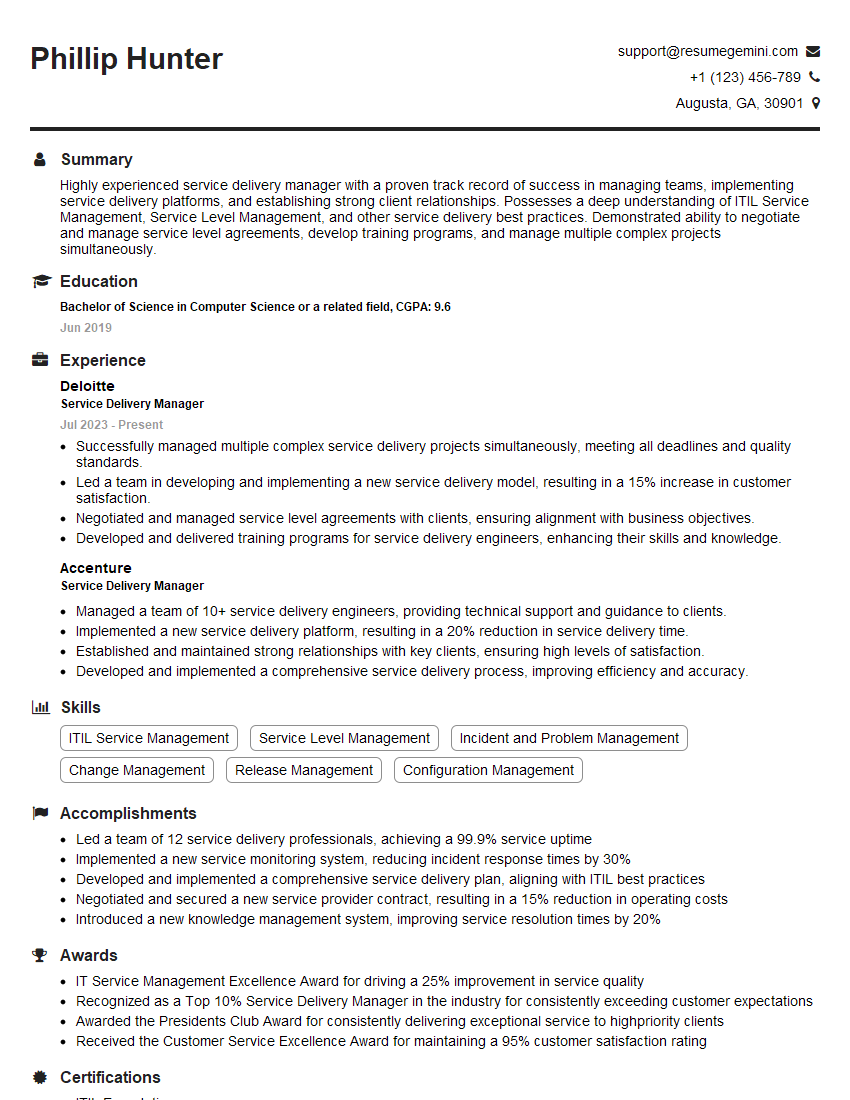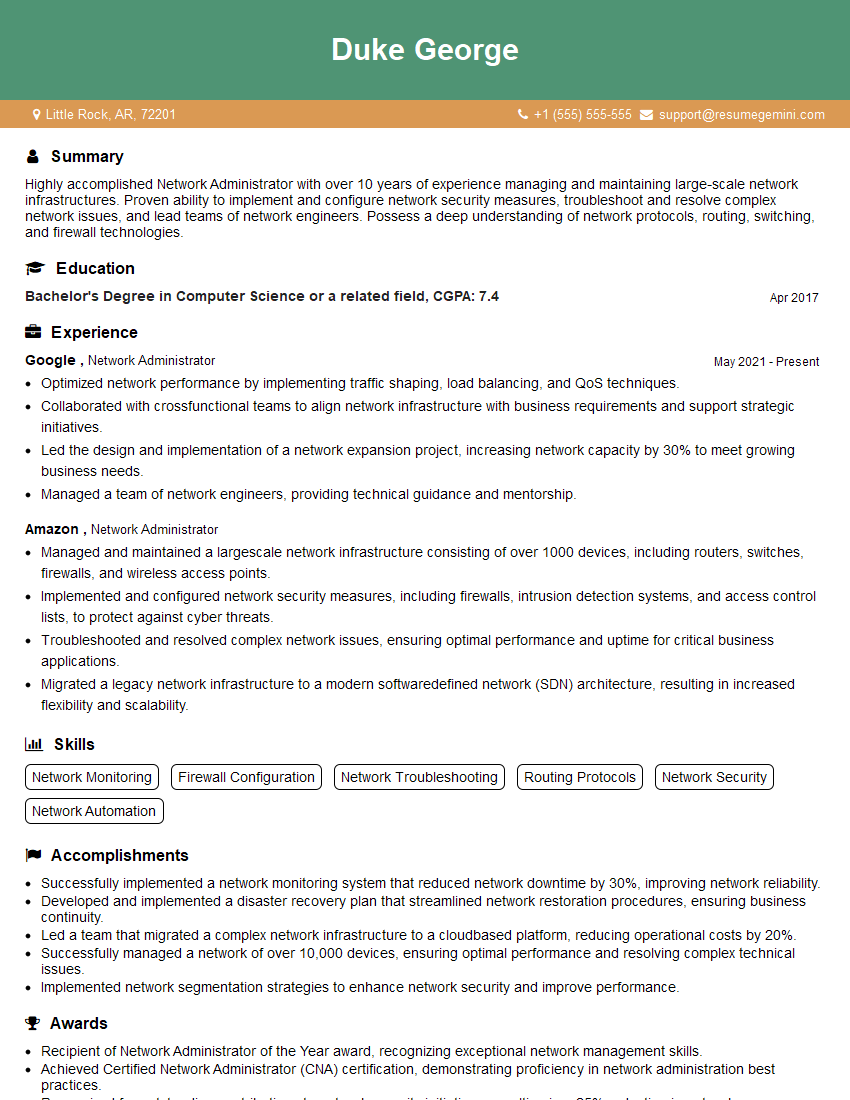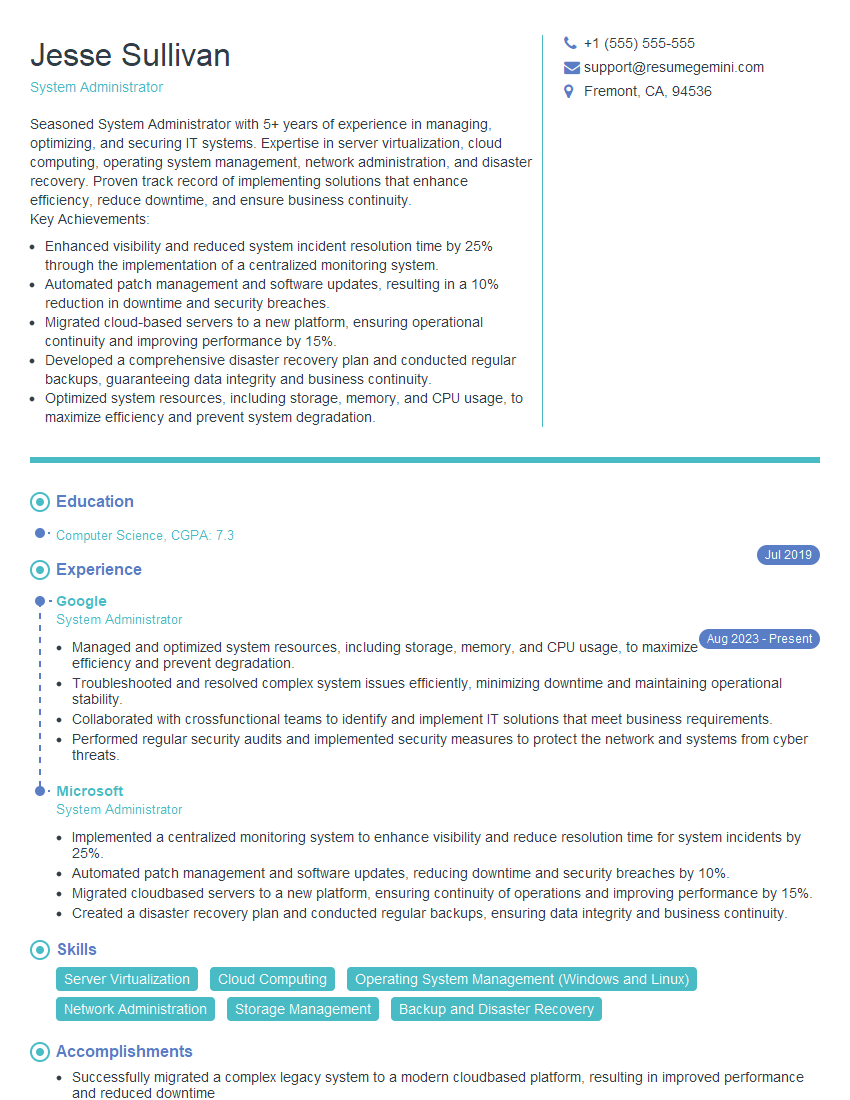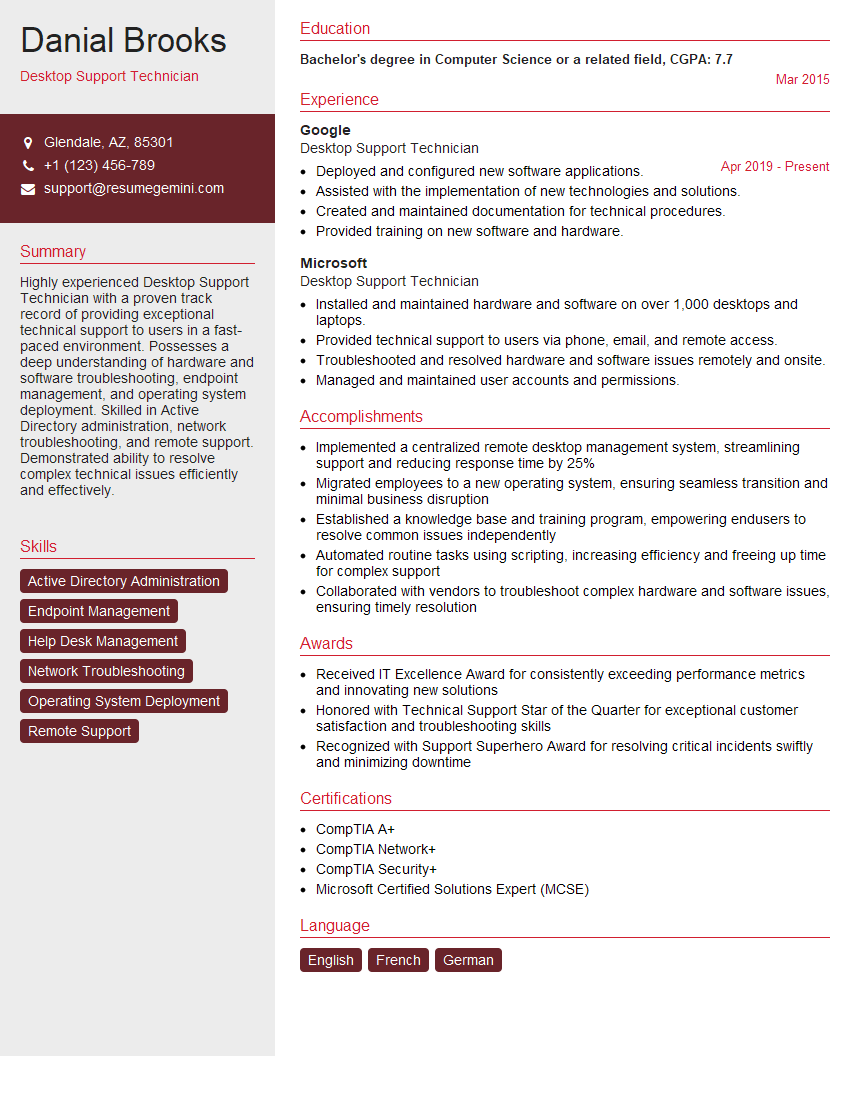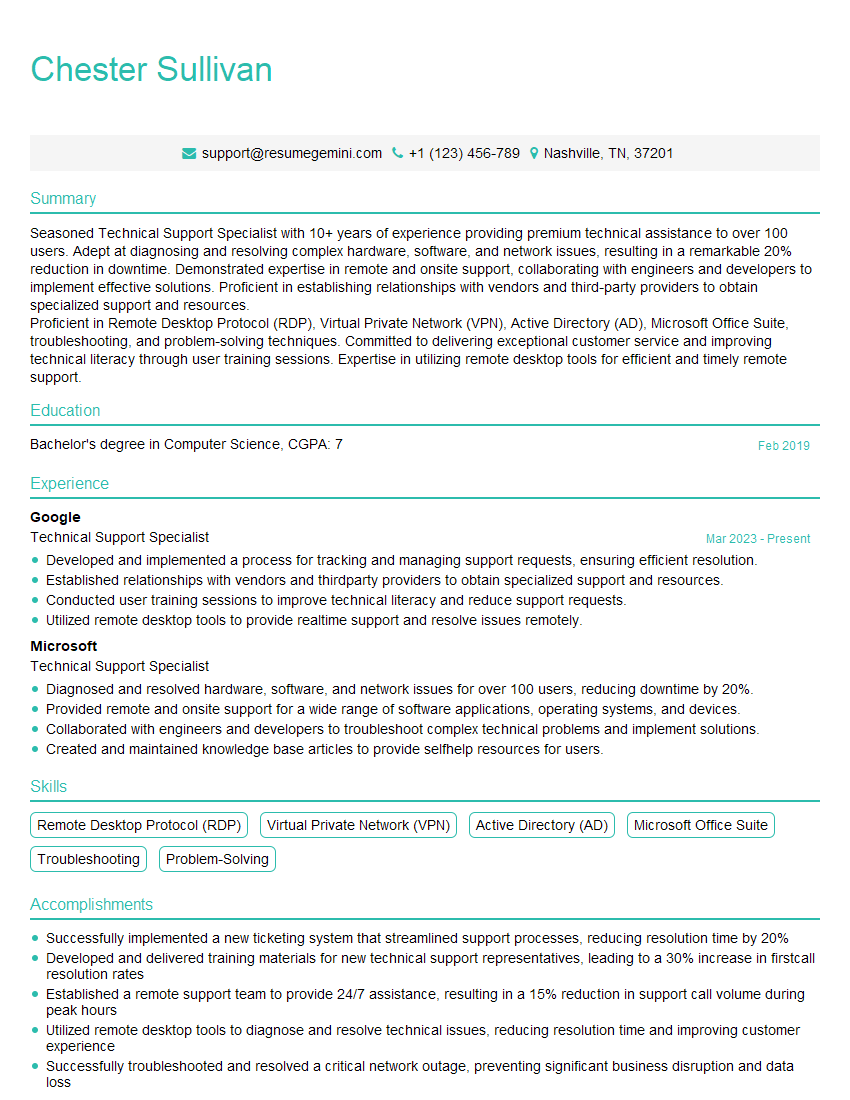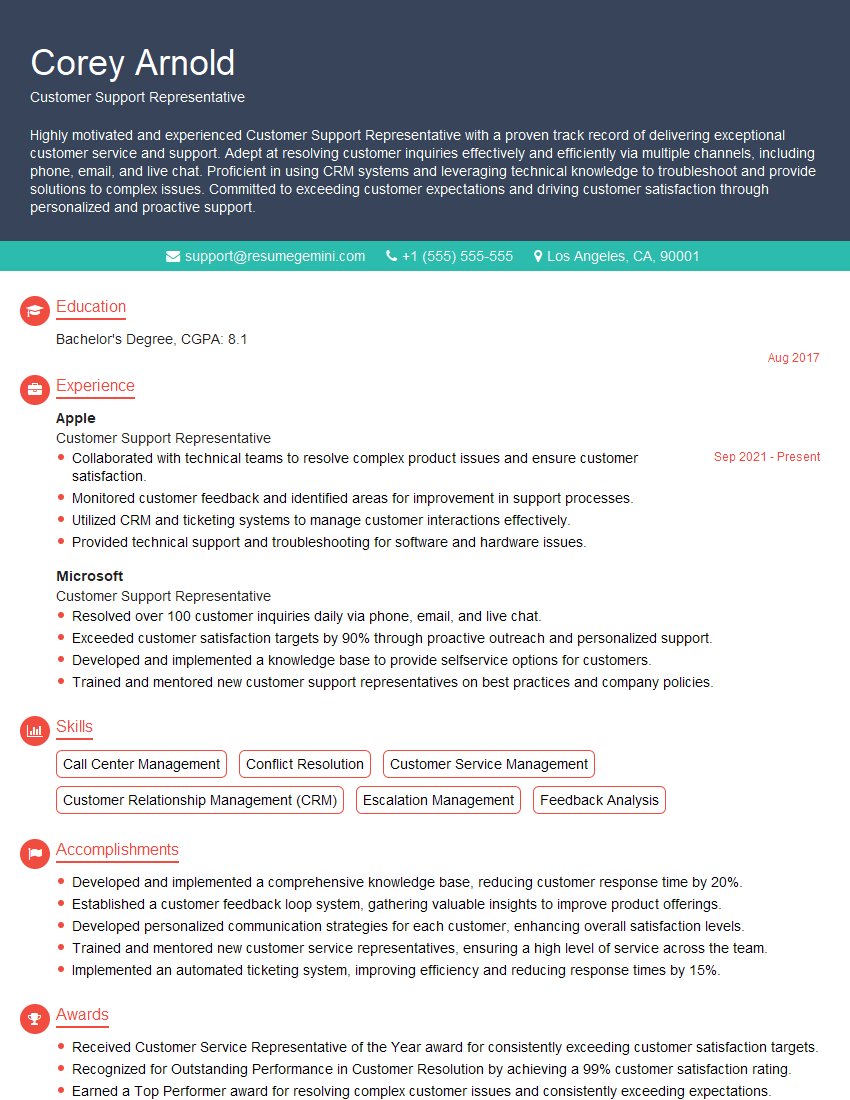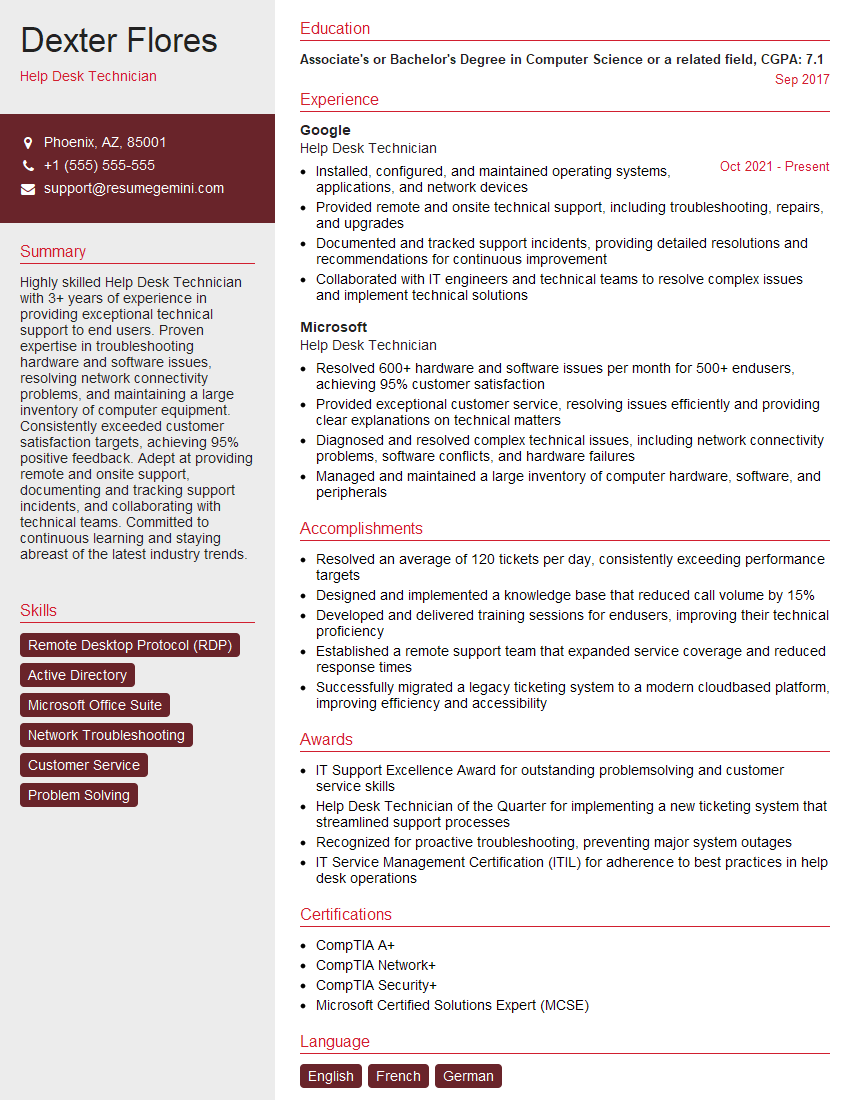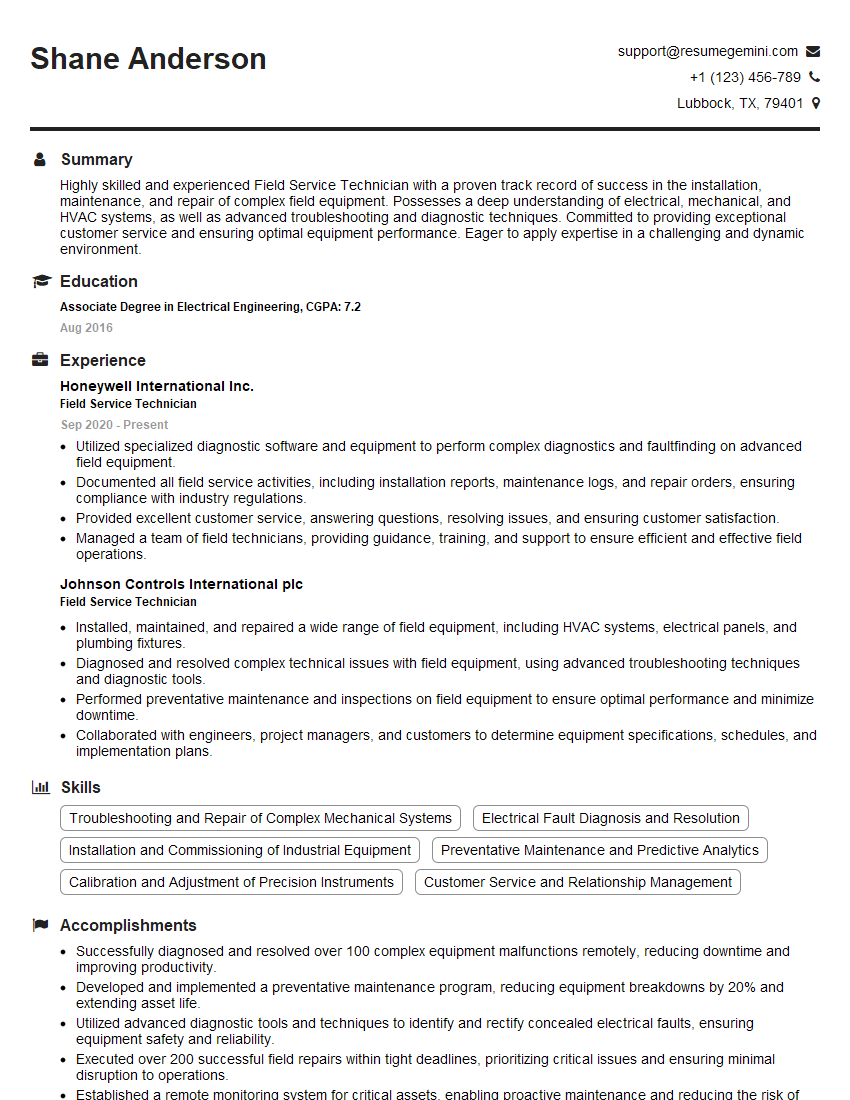Preparation is the key to success in any interview. In this post, we’ll explore crucial Service Playing interview questions and equip you with strategies to craft impactful answers. Whether you’re a beginner or a pro, these tips will elevate your preparation.
Questions Asked in Service Playing Interview
Q 1. Explain the ITIL framework and its relevance to Service Playing.
ITIL, or Information Technology Infrastructure Library, is a widely accepted framework of best practices for IT service management. It provides a structured approach to aligning IT services with business needs. Its relevance to service playing (which I assume refers to providing IT support and services) is paramount because it offers a robust set of processes and procedures to ensure efficient and effective service delivery.
Key ITIL principles directly applicable to service playing include:
- Incident Management: Quickly restoring service to users after an incident occurs. This is the core of daily service playing.
- Problem Management: Identifying the root cause of recurring incidents to prevent future outages. This is crucial for proactive service improvement.
- Change Management: Managing and controlling changes to IT systems to minimize disruption. Service players must carefully manage change requests to avoid impacting services.
- Service Level Management: Defining and managing service level agreements (SLAs) to meet customer expectations. This sets clear expectations for service delivery.
In essence, ITIL provides a roadmap for service players to effectively handle incidents, problems, changes, and overall service delivery, ensuring high availability and customer satisfaction.
Q 2. Describe your experience with ticketing systems (e.g., ServiceNow, Jira).
I have extensive experience with several ticketing systems, including ServiceNow and Jira. In my previous role, we primarily used ServiceNow for managing incidents, problems, changes, and requests. I was responsible for creating, updating, and resolving tickets, ensuring accurate categorization and timely resolution. I was proficient in utilizing ServiceNow’s workflow automation, reporting features, and knowledge base integration to optimize the support process. My experience with Jira was more focused on project management and tracking development tasks, but it complemented my ServiceNow skills by providing insight into the development lifecycle and allowing me to better understand the technical context of certain support issues. I am familiar with the various features of both platforms, such as customized workflows, SLA management, and reporting dashboards, and am comfortable adapting to new ticketing systems quickly.
Q 3. How do you prioritize multiple support requests simultaneously?
Prioritizing multiple support requests requires a structured approach. I typically use a combination of factors including:
- Impact: How many users are affected? A widespread outage affecting critical systems takes precedence over individual user issues.
- Urgency: How quickly does the issue need to be resolved? A critical system failure requiring immediate attention supersedes a less urgent request.
- Severity: How significant is the impact of the issue? A security breach has higher severity than a minor performance issue.
- SLA: Are there any service level agreements (SLAs) that dictate resolution times? SLAs should always be considered.
I often use a matrix or a visual prioritization tool to organize my workload. Imagine a simple matrix with Impact on one axis and Urgency on the other. Issues landing in the high-impact, high-urgency quadrant are addressed immediately. I regularly re-evaluate priorities as new requests come in or situations change.
Q 4. What is your approach to troubleshooting a complex technical issue?
My approach to troubleshooting complex technical issues is systematic and methodical. I follow a structured process:
- Gather information: Begin by collecting as much information as possible from the user, including error messages, steps to reproduce, and affected systems.
- Reproduce the issue: If possible, try to reproduce the problem in a controlled environment to isolate the cause.
- Isolate the problem: Use diagnostic tools and techniques to narrow down the possible causes.
- Test solutions: Once potential solutions are identified, test them thoroughly to ensure they resolve the issue without introducing new problems.
- Document findings: Document all steps taken, findings, and the final solution to assist in future troubleshooting and prevent recurrence.
- Escalate if necessary: If unable to resolve the issue, escalate to a senior engineer or specialist.
I find using a decision tree or flowchart can be very helpful in systematically ruling out possibilities, particularly when dealing with a complex issue with multiple potential contributing factors.
Q 5. Describe your experience with remote support tools.
I’m experienced with various remote support tools including TeamViewer, AnyDesk, and LogMeIn. My proficiency extends beyond simply connecting to a remote system; I understand how to effectively use these tools to diagnose and resolve problems remotely, including sharing screens, transferring files, and controlling the remote computer. I can utilize these tools to perform tasks such as installing software, configuring settings, and troubleshooting network connectivity issues all while maintaining the security and integrity of the remote system. I always prioritize the security of the remote system and adhere to best practices for remote access to protect sensitive information.
Q 6. How do you handle escalated tickets or challenging customers?
Handling escalated tickets and challenging customers requires patience, empathy, and strong communication skills. My approach involves:
- Active listening: Carefully listening to the customer’s concerns and understanding their perspective.
- Empathy: Showing understanding and acknowledging their frustration.
- Clear communication: Explaining technical issues in a clear and concise manner, avoiding jargon.
- Setting expectations: Providing realistic timelines for resolution.
- Following escalation procedures: If unable to resolve the issue, escalate to the appropriate team or manager.
- Documentation: Maintaining detailed records of all communications and actions taken.
I firmly believe that de-escalating a situation through calm and professional communication is crucial. Focusing on solutions rather than placing blame is key to a positive outcome, even in challenging situations.
Q 7. Explain your understanding of incident management processes.
Incident management is the process of identifying, investigating, and resolving incidents that disrupt or threaten to disrupt IT services. Its core goal is to minimize the impact of incidents on business operations and restore services as quickly as possible. This involves a structured approach, often using a workflow similar to this:
- Incident identification: Recognizing that an incident has occurred.
- Incident logging: Recording details of the incident in a ticketing system.
- Incident categorization and prioritization: Classifying the incident based on its impact and urgency.
- Incident investigation and diagnosis: Determining the root cause of the incident.
- Incident resolution: Implementing a solution to restore service.
- Incident closure: Verifying that the incident is resolved and closing the ticket.
- Post-incident review: Analyzing the incident to identify areas for improvement.
Effective incident management relies on clear communication, well-defined processes, and proactive measures to prevent future incidents. It is a cornerstone of service playing, directly impacting customer satisfaction and business continuity.
Q 8. How do you document and track resolutions to support tickets?
Tracking and documenting support ticket resolutions is crucial for maintaining a high-quality service experience and continuous improvement. We use a robust ticketing system, typically integrated with our knowledge base, which allows for detailed logging of every interaction.
Each ticket follows a standardized workflow. Initially, the issue is categorized and assigned a priority level. As the technician works on the resolution, all actions – troubleshooting steps, configurations changed, communication with the customer – are meticulously recorded within the ticket itself using comments and updates.
Upon resolution, the ticket is closed, and a summary of the solution is added. This summary is crucial for knowledge base updates and future troubleshooting. We also use status updates to keep clients informed throughout the process. For example, a status update might say “Awaiting customer response” or “Solution implemented, testing in progress.” This ensures transparency and keeps the client involved. The system also provides reporting and analysis capabilities, allowing us to identify trends and areas for improvement.
Q 9. What metrics do you use to measure the effectiveness of your service playing?
Measuring the effectiveness of service playing involves a multifaceted approach. Key metrics we track include:
- Resolution Time (RT): The time taken to resolve a ticket from initial submission to closure. A shorter RT indicates efficient problem-solving.
- First Contact Resolution (FCR): The percentage of tickets resolved on the first contact with the customer. Higher FCR reflects efficient troubleshooting and readily available solutions.
- Customer Satisfaction (CSAT): Measured through surveys or feedback mechanisms, CSAT reveals the client’s overall experience. A high CSAT score demonstrates successful service delivery.
- Ticket Volume: Monitoring the number of tickets received helps identify trends and potential areas of improvement in the service or product.
- Average Handle Time (AHT): The average time spent handling a ticket, encompassing resolution time, communication time, and other aspects.
By tracking these metrics over time, we can identify areas of strength and weakness in our service delivery. This data-driven approach helps us to continually refine our processes and improve customer satisfaction.
Q 10. Describe your experience with knowledge base systems.
Knowledge base systems are essential for efficient service playing. My experience includes using several different systems, from simple wiki-like platforms to sophisticated, integrated help desks. I’m proficient in creating, updating, and maintaining articles, ensuring they are accurate, concise, and easy to understand for both technical and non-technical users.
I’ve been involved in designing knowledge base structures, categorizing articles effectively using a hierarchical taxonomy, and incorporating multimedia (images, videos) to enhance user comprehension. Furthermore, I’ve implemented search optimization strategies to ensure that users quickly find the information they need. For example, I’ve worked on systems that utilized tagging, keyword optimization, and a robust search algorithm to improve knowledge base searchability and user experience.
I’ve also used knowledge base analytics to track article usage, identify knowledge gaps, and prioritize updates. This ensures the knowledge base remains relevant, accurate, and helpful for resolving issues efficiently.
Q 11. How do you ensure customer satisfaction in a high-pressure environment?
Maintaining customer satisfaction in a high-pressure environment requires a combination of skills and strategies. First and foremost, empathy and clear communication are paramount. Even under stress, I always strive to maintain a calm and professional demeanor, actively listening to the customer’s concerns and validating their feelings.
Effective time management is essential. I prioritize tasks based on urgency and impact, ensuring critical issues are addressed promptly. Open and honest communication keeps clients informed about the progress of their issue, even if it’s just to say that the issue is being worked on and an update will follow shortly. Setting realistic expectations helps to prevent frustration and disappointment.
Finally, proactive problem-solving and seeking help when needed are critical. If I encounter a problem beyond my expertise, I don’t hesitate to escalate it to the appropriate team member while keeping the client updated. This ensures the issue gets resolved quickly and effectively, showcasing teamwork and a commitment to customer satisfaction.
Q 12. Explain your experience with different levels of technical support (Tier 1, Tier 2, Tier 3).
My experience spans all three tiers of technical support: Tier 1, Tier 2, and Tier 3.
- Tier 1: I’ve handled basic troubleshooting and first-line support, resolving common issues through readily available solutions in the knowledge base or using established scripts. This involves dealing directly with end-users, gathering information, and providing clear instructions.
- Tier 2: I’ve worked on more complex issues requiring deeper technical expertise and problem-solving skills. This often involves diagnosing problems that require more in-depth analysis, configuring systems, and escalating issues to Tier 3 when necessary.
- Tier 3: I’ve had exposure to resolving critical incidents, requiring advanced troubleshooting and specialized knowledge. This often involves working with senior engineers, providing detailed analysis and documentation, and implementing permanent solutions to prevent recurrence.
The transition between tiers is seamless. I understand the responsibility of each level and the escalation process, ensuring issues are addressed effectively and efficiently regardless of complexity.
Q 13. How do you identify and escalate critical incidents?
Identifying and escalating critical incidents is crucial for minimizing downtime and ensuring business continuity. We use a combination of monitoring tools, automated alerts, and well-defined escalation procedures.
Critical incidents are identified based on their severity and impact on the business. For example, a complete system outage or a security breach would be classified as a critical incident. Upon detection, the incident is immediately escalated through pre-defined communication channels – often using a dedicated communication platform or on-call system – to the appropriate personnel, depending on the nature of the problem. This typically follows a well-documented runbook, which contains checklists for appropriate actions to be taken.
During the escalation process, a clear summary of the incident, including its impact, symptoms, and initial steps taken, is communicated to ensure the receiving team is well-prepared to take swift action. Regular updates are provided throughout the incident resolution process to all stakeholders.
Q 14. Describe your experience with problem management processes.
Problem management is a proactive approach to prevent recurring incidents. My experience includes participating in root cause analysis (RCA) sessions to determine the underlying cause of incidents, even those that appear isolated. We utilize methodologies like the ‘5 Whys’ to drill down to the root cause, moving beyond superficial symptoms.
Once the root cause is identified, we work collaboratively to develop and implement permanent corrective actions to prevent recurrence. These actions may include system updates, changes to processes, or employee training. We then track the effectiveness of these actions to ensure they have solved the problem. Furthermore, we conduct regular reviews of problem management processes to identify areas for improvement and enhance efficiency. This ensures continuous service improvement and the reduction of recurring incidents.
Q 15. How familiar are you with change management procedures?
Change management, in the context of service playing (which I assume refers to a broader IT service management role), is crucial for minimizing disruption and maximizing the success of any alteration to systems, processes, or services. My familiarity extends beyond simply knowing the steps; I understand the importance of stakeholder management, risk assessment, and communication at every stage.
My approach typically involves a structured process: First, I conduct a thorough impact assessment, identifying all potential stakeholders and their dependencies. Next, I develop a detailed plan that includes timelines, responsibilities, and rollback strategies. This plan is then communicated transparently to stakeholders, ensuring everyone understands the changes and their implications. Throughout the implementation, I monitor progress closely, addressing any issues proactively. Post-implementation, I gather feedback and conduct a thorough review to identify areas for improvement in future changes. For example, during a recent database migration, we used a phased rollout approach with rigorous testing at each stage, minimizing downtime and ensuring data integrity.
Career Expert Tips:
- Ace those interviews! Prepare effectively by reviewing the Top 50 Most Common Interview Questions on ResumeGemini.
- Navigate your job search with confidence! Explore a wide range of Career Tips on ResumeGemini. Learn about common challenges and recommendations to overcome them.
- Craft the perfect resume! Master the Art of Resume Writing with ResumeGemini’s guide. Showcase your unique qualifications and achievements effectively.
- Don’t miss out on holiday savings! Build your dream resume with ResumeGemini’s ATS optimized templates.
Q 16. What is your approach to proactive problem prevention?
Proactive problem prevention is paramount in service playing. It’s far more efficient and cost-effective to prevent problems than to react to them. My approach focuses on several key areas:
- Monitoring and Alerting: Implementing robust monitoring systems to detect potential issues before they impact users. This includes setting up alerts for key performance indicators (KPIs) and thresholds. For instance, I’ve configured alerts for CPU utilization, disk space, and network latency to proactively identify potential bottlenecks.
- Regular Maintenance: Performing scheduled maintenance tasks such as patching systems, updating software, and cleaning up logs. This reduces the risk of vulnerabilities and system instability.
- Capacity Planning: Proactively assessing resource needs to ensure systems can handle current and future demands. We avoided a major service outage by predicting a surge in traffic during a promotional event and proactively scaling our infrastructure.
- Automation: Automating repetitive tasks reduces human error and improves efficiency. For example, I’ve automated backups and security scans.
- Root Cause Analysis: Thoroughly investigating past incidents to identify underlying causes and implement preventative measures. After a recent network outage, we discovered a misconfiguration in our firewall rules, which we corrected and implemented additional checks to avoid recurrence.
Q 17. How do you stay updated on new technologies and industry best practices?
Staying current in the rapidly evolving world of IT requires a multifaceted approach. I regularly engage in the following activities:
- Industry Publications and Blogs: I subscribe to leading IT publications and follow influential blogs and technology news websites to stay informed about emerging technologies and best practices.
- Professional Development Courses and Certifications: I actively pursue relevant certifications and attend training courses to enhance my skills and knowledge. Recent examples include completing advanced courses in cloud computing and cybersecurity.
- Conferences and Workshops: Attending industry conferences and workshops allows me to network with peers and learn from experts in the field.
- Open Source Contributions and Community Engagement: Participating in open-source projects and engaging with online communities provides valuable insights and exposure to different approaches and technologies.
- Internal Knowledge Sharing: Actively sharing my knowledge and expertise with colleagues through presentations, documentation, and mentoring fosters continuous learning within the team.
Q 18. Describe your experience working with different operating systems (Windows, macOS, Linux).
I’m proficient in working with various operating systems, including Windows, macOS, and Linux. My experience spans across various distributions of Linux, including Ubuntu, CentOS, and Red Hat. I’m comfortable managing users, permissions, installing software packages, troubleshooting system issues, and configuring network settings on all three platforms. The specific commands and techniques differ across platforms, but the underlying principles of system administration remain consistent. For example, while managing user accounts involves using the net user command on Windows, it involves using the useradd command on Linux systems.
Q 19. How comfortable are you with command-line interfaces?
I’m highly comfortable with command-line interfaces (CLIs). I find them to be significantly more efficient for many administrative tasks compared to graphical user interfaces (GUIs). I routinely use the command line for tasks such as system monitoring, log analysis, remote server management, scripting, and automation. My proficiency extends to using various shells such as Bash, Zsh, and PowerShell. For example, I frequently use ps aux (Linux/macOS) or tasklist (Windows) to monitor system processes, and grep (Linux/macOS) or findstr (Windows) to search through log files for specific events.
Q 20. What is your experience with network troubleshooting?
Network troubleshooting is a significant part of my experience in service playing. My approach is systematic and follows a structured methodology:
- Gather Information: Start by collecting information about the issue, including the affected users, services, and symptoms.
- Identify the Scope: Determine the extent of the problem – is it impacting a single machine, a segment of the network, or the entire network?
- Check Basic Connectivity: Verify basic connectivity using tools like
pingandtraceroute. - Analyze Network Logs: Examine network device logs for error messages or unusual activity.
- Check Network Devices: Inspect routers, switches, and firewalls for any configuration issues or failures.
- Use Network Monitoring Tools: Employ network monitoring tools to gather performance metrics and identify bottlenecks.
- Test Network Cabling: In case of physical network issues, test the integrity of network cabling.
A recent example involved troubleshooting intermittent connectivity issues. By analyzing network logs, we identified a faulty switch port, which was promptly replaced, resolving the issue.
Q 21. Describe your experience with hardware troubleshooting.
My hardware troubleshooting experience involves diagnosing and resolving issues related to servers, workstations, and network devices. I follow a structured approach:
- Visual Inspection: Begin by visually inspecting the hardware for any physical damage, loose connections, or overheating.
- Power Cycle: Perform a power cycle of the affected hardware to rule out temporary glitches.
- Diagnostics Tools: Use built-in diagnostic tools provided by the hardware manufacturer to identify potential problems.
- Component Testing: If necessary, isolate the issue by testing individual components (e.g., RAM, hard drives) to pinpoint the faulty component.
- Replace Faulty Components: Replace faulty hardware components and verify functionality.
- BIOS/UEFI Settings: Check BIOS/UEFI settings to ensure proper configurations.
For example, I once resolved a server failure by identifying a failing hard drive using SMART (Self-Monitoring, Analysis and Reporting Technology) data and replacing it before data loss occurred.
Q 22. How do you handle situations where you don’t know the answer?
Honesty and transparency are paramount when I don’t know an answer. I would never pretend to have knowledge I don’t possess. Instead, I’d acknowledge the gap in my knowledge, clearly state that I need to research the issue, and provide a realistic timeframe for getting back with a solution. For instance, if faced with a complex service interaction issue I haven’t encountered before, I would first gather all relevant information – logs, error messages, system configurations – then outline the steps I would take to diagnose the problem (e.g., checking documentation, reviewing troubleshooting guides, consulting with colleagues). I’d then provide regular updates on my progress.
This approach builds trust and shows a commitment to finding the solution, rather than trying to cover up a lack of understanding. I find that proactively seeking help when needed, and documenting the process for future reference, is a more efficient and sustainable strategy than trying to ‘wing it’.
Q 23. How do you collaborate effectively with other teams?
Effective collaboration is key in service playing. I leverage tools like Jira and Slack for efficient communication and task management. I value active listening and clear communication; I make sure to articulate my needs and ideas clearly, while also ensuring I understand the perspectives and challenges of other team members. For example, when working with the development team to resolve a recurring service outage, I would proactively share performance metrics, error logs, and user impact reports. This ensures everyone is on the same page and working towards a common goal. Open and honest feedback, coupled with a collaborative problem-solving approach is crucial.
I’ve found that regular meetings, even brief stand-ups, can be immensely helpful in maintaining momentum and transparency. These are especially effective in identifying potential roadblocks early and coordinating responses.
Q 24. What is your experience with service level agreements (SLAs)?
I have extensive experience working with Service Level Agreements (SLAs). I understand the importance of clearly defined metrics, such as uptime, response time, and resolution time. My experience includes negotiating SLAs with stakeholders, monitoring performance against those agreements, and escalating issues when necessary. I’m proficient in using monitoring tools to track key performance indicators (KPIs) and identify potential breaches of the SLA before they impact users. For example, if a service consistently falls short of the agreed-upon uptime target, I would analyze the root cause, implement corrective actions, and work with relevant teams to prevent future occurrences. I also understand the importance of regular SLA reviews to ensure they remain aligned with business needs and technological advancements.
I believe SLAs are not just about measuring performance; they are also a tool for improving service quality and fostering a culture of accountability.
Q 25. How do you manage your time effectively?
Effective time management is crucial in my role. I utilize a combination of techniques, including task prioritization using methods like the Eisenhower Matrix (urgent/important), time blocking, and regular review of my to-do list. I focus on completing high-priority tasks first and breaking down larger projects into smaller, more manageable steps. I also leverage project management tools to track progress and manage dependencies. This helps to ensure that I allocate my time effectively and meet deadlines consistently. For example, if I have multiple critical incidents to handle simultaneously, I prioritize them based on the impact on users and the urgency of resolution.
Regularly reviewing my workload and adjusting my priorities as needed allows me to adapt to changing circumstances and avoid feeling overwhelmed. I also make sure to schedule regular breaks to maintain focus and avoid burnout.
Q 26. Describe your experience with capacity planning.
Capacity planning is a critical aspect of service management. My experience includes forecasting future demand, analyzing resource utilization, and recommending appropriate scaling strategies. I’ve worked with various tools and techniques, including performance testing, trend analysis, and historical data analysis to determine the optimal capacity required to meet future service demands. For example, in anticipation of a significant increase in user traffic during a promotional campaign, I would conduct performance testing to identify potential bottlenecks and ensure that the infrastructure can handle the increased load. I would then work with the infrastructure team to plan for necessary upgrades or scaling to prevent service disruptions. This could involve adding more servers, upgrading network bandwidth, or optimizing database performance.
Capacity planning isn’t a one-time event; it’s an ongoing process requiring continuous monitoring and adjustment based on actual usage and predicted trends.
Q 27. How do you handle stressful situations?
I handle stressful situations by adopting a structured approach. First, I focus on understanding the situation – identifying the root cause of the stress and its potential impact. Then, I prioritize tasks based on urgency and importance and develop a plan to address the situation methodically. I believe in seeking support from colleagues and mentors when necessary; collaborative problem-solving can effectively reduce stress and improve outcomes. Furthermore, I maintain a healthy work-life balance to prevent burnout. This includes regular exercise, sufficient sleep, and engaging in activities I enjoy outside of work. Taking short breaks throughout the day can also significantly reduce stress levels.
In high-pressure situations, I focus on calm and controlled communication, ensuring clear and concise updates to stakeholders. Deep breaths and maintaining a positive attitude are also helpful strategies.
Q 28. What are your salary expectations?
My salary expectations are commensurate with my experience and skills, and in line with the industry standard for a Service Playing role with my level of expertise. I am open to discussing this further once I have a better understanding of the specifics of the role and the compensation package offered. I am more interested in a role that provides growth opportunities and challenges that allow me to leverage and expand my skills.
Key Topics to Learn for Service Playing Interview
- Understanding Client Needs: Analyzing client requirements, identifying pain points, and translating them into actionable service strategies.
- Service Delivery Models: Familiarity with various service delivery models (e.g., Agile, Waterfall) and their practical applications in different contexts.
- Service Level Agreements (SLAs): Defining, negotiating, and managing SLAs to ensure client satisfaction and operational efficiency.
- Proactive Problem Solving: Identifying potential service disruptions before they occur and implementing preventative measures.
- Communication & Collaboration: Effective communication strategies for interacting with clients, colleagues, and stakeholders.
- Performance Monitoring & Reporting: Tracking key performance indicators (KPIs), generating reports, and using data to drive improvements.
- Continuous Improvement Methodologies: Applying methodologies like Kaizen or Six Sigma to optimize service processes and enhance client experience.
- Risk Management in Service Delivery: Identifying, assessing, and mitigating risks that could impact service delivery.
- Technical Proficiency (if applicable): Depending on the specific role, demonstrating knowledge of relevant technologies and tools used in service delivery.
- Troubleshooting & Resolution: Developing effective problem-solving skills to address service issues promptly and efficiently.
Next Steps
Mastering Service Playing is crucial for career advancement, opening doors to leadership roles and high-impact opportunities. A strong, ATS-friendly resume is your key to unlocking these possibilities. ResumeGemini can help you craft a compelling resume that highlights your skills and experience in Service Playing, maximizing your chances of landing your dream job. Examples of resumes tailored to Service Playing are available to further guide your preparation.
Explore more articles
Users Rating of Our Blogs
Share Your Experience
We value your feedback! Please rate our content and share your thoughts (optional).
What Readers Say About Our Blog
Hey, I know you’re the owner of interviewgemini.com. I’ll be quick.
Fundraising for your business is tough and time-consuming. We make it easier by guaranteeing two private investor meetings each month, for six months. No demos, no pitch events – just direct introductions to active investors matched to your startup.
If youR17;re raising, this could help you build real momentum. Want me to send more info?
Hi, I represent an SEO company that specialises in getting you AI citations and higher rankings on Google. I’d like to offer you a 100% free SEO audit for your website. Would you be interested?
Hi, I represent an SEO company that specialises in getting you AI citations and higher rankings on Google. I’d like to offer you a 100% free SEO audit for your website. Would you be interested?
good
